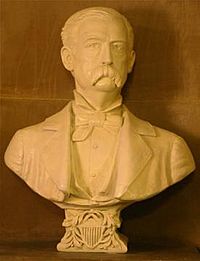Bust of Daniel W. Voorhees facts for kids
The Daniel W. Voorhees bust is a public artwork created by American artist James Paxton Voorhees. You can find it on the second floor of the Indiana Statehouse in Indianapolis, Indiana. This sculpture honors Daniel W. Voorhees, a famous Indiana politician from the 1800s. People called him the "Tall Sycamore of the Wabash" because he was very tall with broad shoulders and a large head.
Contents
What Does the Daniel W. Voorhees Bust Look Like?
The Daniel W. Voorhees sculpture is a plaster bust, which means it shows only the head and shoulders of a person. It is painted white and is about 31 inches tall, 27 inches wide, and 18 inches deep.
In the sculpture, Voorhees looks slightly up and to his left. His right eyebrow is a little raised. His hair is combed back from a side part. He has a long, bushy mustache that covers his mouth and reaches his chin. He wears a formal coat over a vest and a high-collared shirt. A tie is fastened in a bow at his neck.
The bust rests on a base decorated with olive branches. These branches partly surround a coat of arms or crest, which has eleven stars and seven stripes.
Below the bust, a plaque shares important facts about Daniel W. Voorhees:
- Born: September 26, 1827
- Died: April 9, 1897
- Served as a Congressman: 1861–1865, 1868–1873
- Served as a United States Senator: 1877–1897
- He was a trial lawyer and a great speaker.
- He strongly supported creating the Library of Congress.
History of the Voorhees Bust
The artist, James P. Voorhees (1855–1936), was actually Daniel W. Voorhees' son. He worked as his father's secretary for 21 years. After his father passed away in 1897, James P. Voorhees created this bust. He wanted to remember his father's important work in helping to establish the Library of Congress. Daniel W. Voorhees was the chairman of a Senate committee that planned and pushed for the library's creation.
The bust was given to Governor James Frank Hanly, who was governor from 1905 to 1909, for the Indiana Statehouse.
Where the Bust Has Been Located
Over the years, the Daniel W. Voorhees bust has been moved around the Indiana Statehouse.
- In 1943, it was on the third floor, facing south.
- By 1982, it was still on the third floor, joined by other sculptures.
You can find another copy of the Daniel W. Voorhees bust in Terre Haute, Indiana, at the Vigo County Historical Society. This copy was given to the Emeline Fairbanks Memorial Library in Terre Haute in 1906.
About the Artist: James P. Voorhees
James P. Voorhees was a talented person who worked as a sculptor, an actor, and an author.
He created other sculptures, including a bust of Richard Mentor Johnson, who was the ninth Vice President of the United States. This bust was placed in the United States Senate chamber in 1895. A year later, James P. Voorhees was chosen to sculpt a bust of John C. Breckinridge, the 14th Vice President. He also made busts of famous figures like Thomas Jefferson and Napoleon Bonaparte.
James P. Voorhees as an Actor
In September 1897, a few months after his father died, James P. Voorhees began performing. He gave speeches and monologues in a style that reminded people of his father's powerful speaking.
About a year later, James P. Voorhees started working on a plan to create a national theater in Washington, D.C.. Many famous actors of that time, such as Richard Mansfield and Henry Irving, supported his idea. The plan was introduced to the United States House of Representatives in December 1902.
James P. Voorhees as an Author
James P. Voorhees also wrote and published several books of poetry and stories. Some of his works include Caverns of Dawn (1910) and Flaws: A Story of Hoosierlands (1925). He wrote Flaws while staying at a hotel in Plainfield, Indiana. He also exchanged letters with James Whitcomb Riley, who was known as the “Hoosier Poet.”
See also
 In Spanish: Busto de Daniel W. Voorhees para niños
In Spanish: Busto de Daniel W. Voorhees para niños


